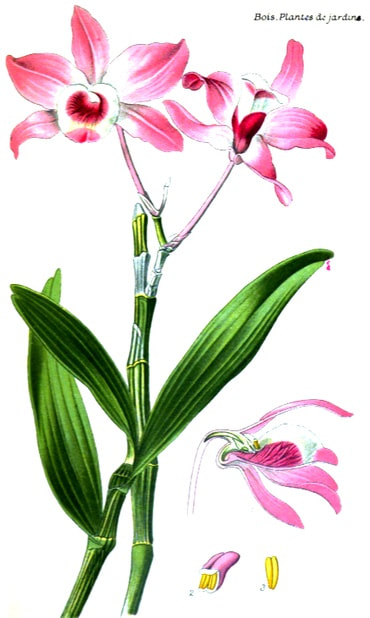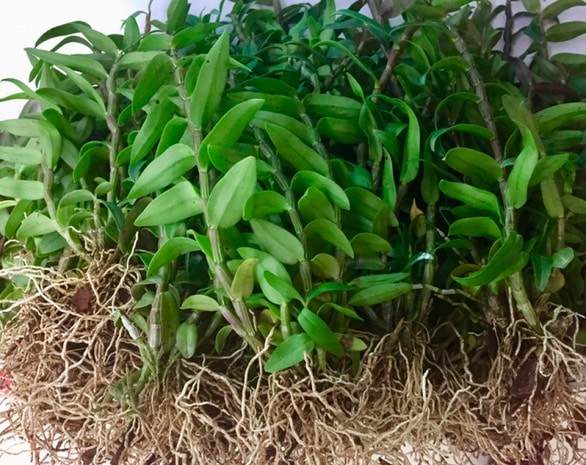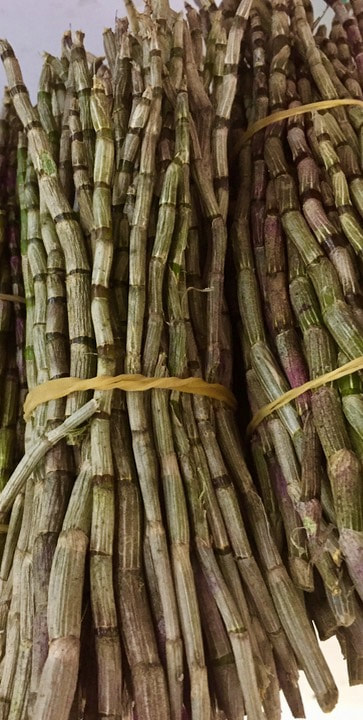Dendrobium nobile, Shi Hu 石斛
Shi Hu (TCM)
Pu shel rtse པུ་ཤེལ་རྩི (Tibet)
Pu shel rtse པུ་ཤེལ་རྩི (Tibet)
Dendrobium nobile
Atlas des plantes de jardins, Klincksieck, 1896
Atlas des plantes de jardins, Klincksieck, 1896
Botanical name:
Dendrobium spp.
D. nobile, D. candidum, D. fimbriatum are listed in the Chinese Pharmacopoeia.
Parts used:
Herb / stem, fresh or dried
Temperature & Taste:
Cool, moist. Sweet, slightly Salty
Classifications:
N. Yin Tonics
Dendrobium spp.
D. nobile, D. candidum, D. fimbriatum are listed in the Chinese Pharmacopoeia.
Parts used:
Herb / stem, fresh or dried
Temperature & Taste:
Cool, moist. Sweet, slightly Salty
Classifications:
N. Yin Tonics
ADVERTISEMENT:
Uses:
1. Nourishes, Yin, Generates Fluids, Clears Heat: (TCM, Tibet)
-Fever from Yin deficiency; Hectic Fever
-Dry Mouth, severe Thirst
-in Tibet for urge to vomit (from excess Stomach heat)
2. Nourishes Kidney Yin: (TCM, Tibet)
-Kidney Yin deficiency with low-grade Fever, Thirst, poor vision, aches and pains, red tongue with no coating
-in Tibet for obstructions of the Urinary passages
-'tonifies the consumptive condition of the Five Viscera'. (Shen Nong Ben Cao)
3. Strengthens the Kidneys, Nourishes Essence: (TCM)
-weakness of the Lower back and legs
-Dizziness or chronic Headache
-failing Vision and Night-blindness
-'enhances male sexuality and reinforces Jing (Vital Essence).' (Shen Nong Ben Cao)
-'makes one feel happy and vigorous and able to enjoy long life'. (Ming Yi Bie Lu)
-'heightens intelligence' (Da Ming)
Dose:
Decoction: 6–12 grams
Preparation:
... available in PRO version
Substitute:
... available in PRO version
Decoction: 6–12 grams
Preparation:
... available in PRO version
Substitute:
... available in PRO version
Main Combinations:
1. Stomach Yin deficiency, ... available in PRO version
2. Low-Grade fever, thirst, Dendrobium Shi Hu with ... available in PRO version
3. High fever, Toxic fever, acute and chronic Fever, Dendrobium Shi Hu with ... available in PRO version
4. Dry mouth, low-grade Fever, with Fatigue:
i. Dendrobium Shi Hu with ... available in PRO version
ii. Dendrobium Shi Hu with ... available in PRO version
5. Lung heat with Spleen deficiency, Dendrobium Shi Hu ... available in PRO version
6. Cough from Yin deficiency with Heat, Dendrobium Shi Hu with ... available in PRO version
7. Kidney Yin deficiency, Dendrobium Shi Hu with ... available in PRO version
8. Yin deficiency with Irritability, Dendrobium Shi Hu with ... available in PRO version
9. Diabetes from Stomach Heat and Kidney Yin deficiency, Dendrobium Shi Hu with ... available in PRO version
10. Cold-Damp Rheumatism, Dendrobium Shi Hu with ... available in PRO version
11. Liver heat, Dendrobium Shi Hu with ... available in PRO version
12. Poor, Blurred or Failing Vision, Dizziness, Dendrobium Shi Hu with ... available in PRO version
13.. Weakness of the Lower Back and Legs, Dendrobium Shi Hu with ... available in PRO version
Major Formulas:
Di Huang Yin Zi
Qing Re Bao Jing Fa
Qing Shu Yi Qi Tang
Qing Zao Run Chang Tang
Qu Fan Yang Wei Tang
Camphor 25 (Tibetan Medicine)
Emblic 25 (Skyu ru nyer lnga) (Tibetan Medicine)
ADVERTISEMENT:
Cautions:
1. Cool and moist, it is apt to increase Dampness.
2. Not used in Spleen deficiency with loose stool and a greasy tongue coating.
CITES listing:
This medicine is listed as endangered on CITES. However, it is farmed on a large scale for medicine and as an ornamental.
Main Preparations used:
1. Cool and moist, it is apt to increase Dampness.
2. Not used in Spleen deficiency with loose stool and a greasy tongue coating.
CITES listing:
This medicine is listed as endangered on CITES. However, it is farmed on a large scale for medicine and as an ornamental.
Main Preparations used:






